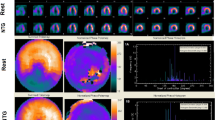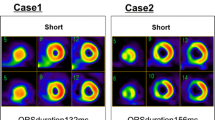Abstract
Background
We evaluated whether dobutamine stress technetium 99m tetrofosmin (DSTF) quantitative gated single photon emission computed tomography (QGS) could predict late spontaneous improvement of cardiac function in patients with idiopathic dilated cardiomyopathy (DCM).
Methods and Results
The study included 26 patients with recently diagnosed (>2 months) idiopathic DCM and a left ventricular ejection fraction (LVEF) lower than 45%. DSTF- QGS was performed in all patients to measure LVEF at rest and during dobutamine infusion (10 μg · kgμ1 · minμ1). LVEF and left ventricular end- diastolic volume (LVEDV) were determined by echocardiography, and New York Heart Association (NYHA) functional class was estimated at baseline and after 1 year. After 1 year of treatment, the echocardiographic LVEF improved by greater than 5% in 13 patients (group A) but did not improve in the remaining 13 patients (group B). At baseline, the echocardiographic LVEF, LVEDV, and NYHA functional class were similar in both groups. However, there was a greater increase in the LVEF during the dobutamine infusion portion of the DSTF- QGS (Δ LVEF) in group A than in group B (13.1% α 5.9% vs 2.6% α 4.1%, P > .0001). If a critical value for the μLVEF of 7.0% was used to predict improvement in LVEF after treatment, the sensitivity was 84.7% and the specificity was 84.7%. LVEDV and NYHA functional class improved to a greater extent in group A than in group B.
Conclusions
DSTF-QGS can be used to predict late spontaneous improvement in cardiac function and symptoms after treatment in patients with idiopathic DCM.
Similar content being viewed by others
References
Sugrue DD, Rodeheffer RJ, Codd MB et al. The clinical course of idiopathic dilated cardiomyopathy. A population-based study. Ann Intern Med 1992;117:117–23.
Cetta F, Michels VV. The natural history and spectrum of idiopathic dilated cardiomyopathy, including HIV and peripartum cardiomyopathy. Curr Opin Cardiol 1995;10:332–8.
Schwarz F, Mall G, Zebe H, et al. Determinants of survival in patients with congestive cardiomyopathy: quantitative morphologic findings and left ventricular hemodynamics. Circulation 1984;70:923–8.
Steimle AE, Stevenson LW, Fonarow GC, Hamilton MA, Moriguchi JD. Prediction of improvement in recent onset cardiomyopathy after referral for heart transplantation. J Am Coll Cardiol 1994;23: 553–9.
Mann-Rouillard V, Fishbein MC, Naqvi TZ, DonMichael TA, Siegel RJ. Frequency of echocardiographic improvement in left ventricular cavity size and contractility in idiopathic-dilated cardiomyopathy. Am J Cardiol 1999;83:131–3.
Dec GW Jr, Palacios IF, Fallon JT, et al. Active myocarditis in the spectrum of acute dilated cardiomyopathies. Clinical features, histologic correlates, and clinical outcome. N Engl J Med 1985; 312:885–90.
Tuttle RR, Mills J. Dobutamine: development of a new catecholamine to selectively increase cardiac contractility. Circ Res 1975; 36:185–96.
Kasama S, Toyama T, Hoshizaki H, et al. Dobutamine gated blood pool scintigraphy predicts the improvement of cardiac sympathetic nerve activity, cardiac function, and symptoms after treatment in patients with dilated cardiomyopathy. Chest 2002;122:542–8.
Naqvi TZ, Goel RK, Forrester JS, Siegel RJ. Myocardial contractile reserve on dobutamine echocardiography predicts late spontaneous improvement in cardiac function in patients with recent onset idiopathic dilated cardiomyopathy. J Am Coll Cardiol 1999;34:1537–44.
Pratali L, Picano E, Otasevic P, et al. Prognostic significance of the dobutamine echocardiography test in idiopathic dilated cardiomyopathy. Am J Cardiol 2001;88:1374–8.
Drozdz J, Krzeminska-Pakula M, Plewka M, Ciesielczyk M, Kasprzak JD. Prognostic value of low-dose dobutamine echocardiography in patients with idiopathic dilated cardiomyopathy. Chest 2002;121:1216–22.
Germano G, Kavanagh PB, Su HT, et al. Automatic reorientation of three-dimensional, transaxial myocardial perfusion SPECT images. J Nucl Med 1995;36:1107–14.
Germano G, Kiat H, Kavanagh PB, et al. Automatic quantification of ejection fraction from gated myocardial perfusion SPECT. J Nucl Med 1995;36:2138–47.
Germano G, Erel J, Lewin H, Kavanagh PB, Berman DS. Automatic quantitation of regional myocardial wall motion and thickening from gated technetium-99m sestamibi myocardial perfusion single-photon emission computed tomography. J Am Coll Cardiol 1997;30:1360–7.
Leoncini M, Sciagra R, Maioli M, et al. Usefulness of dobutamine Tc-99m sestamibi-gated single-photon emission computed tomography for prediction of left ventricular ejection fraction outcome after coronary revascularization for ischemic cardiomyopathy. Am J Cardiol 2002;89:817–21.
Yamagishi H, Akioka K, Hirata K, et al. Dobutamine stress electrocardiography-gated Tc-99m tetrofosmin SPECT for detection of viable but dysfunctional myocardium. J Nucl Cardiol 2001;8:58–67.
Chin BB, Esposito G, Kraitchman DL. Myocardial contractile reserve and perfusion defect severity with rest and stress dobutamine (99m)Tc-sestamibi SPECT in canine stunning and subendocardial infarction. J Nucl Med 2002;43:540–50.
Kasama S, Toyama T, Kumakura H, et al. Low-dose dobutamine stress 99mTc tetrofosmin quantitative gated SPECT performed during the acute phase of myocardial infarction predicts subsequent myocardial viability and detects stunned myocardium. Nucl Med Commun 2003;24:167–74.
Schiller NB, Shah PM, Crawford M, et al. Recommendations for quantitation of the left ventricle by two-dimensional echocardiography. American Society of Echocardiography Committee on Standards, Subcommittee on Quantitation of Two-Dimensional Echocardiograms. J Am Soc Echocardiogr 1989;2:358–67.
Francis GS, Johnson TH, Ziesche S, et al. Marked spontaneous improvement in ejection fraction in patients with congestive heart failure. Am J Med 1990;89:303–7.
Cross AM Jr, Steenbergen C, Higginbotham MB. Recovery of left ventricular function in acute nonischemic congestive cardiomyopathy. Am Heart J 1995;129:24–30.
Andy JJ, Curry CL, Ali N, Mehrotra PP. Cardiovascular effects of dobutamine in severe congestive heart failure. Am Heart J 1977; 94:175–82.
Leier CV, Unverferth DV. Drugs five years later. Dobutamine. Ann Intern Med 1983;99:490–6.
Meyer SL, Curry GC, Donsky MS, et al. Influence of dobutamine on hemodynamics and coronary blood flow in patients with and without coronary artery disease. Am J Cardiol 1976;38:103–8.
Mikulic E, Cohn JN, Franciosa JA. Comparative hemodynamic effects of inotropic and vasodilator drugs in severe heart failure. Circulation 1977;56(4 Pt 1):528–33.
Leier CV, Unverferth DV, Kates RE. The relationship between plasma dobutamine concentrations and cardiovascular responses in cardiac failure. Am J Med 1979;66:238–42.
Kates RE, Leier CV. Dobutamine pharmacokinetics in severe heart failure. Clin Pharmacol Ther 1978;24:537–41.
Vasu MA, O’Keefe DD, Kapellakis GZ, et al. Myocardial oxygen consumption: effects of epinephrine, isoproterenol, dopamine, norepinephrine, and dobutamine. Am J Physiol 1978;235:H237–41.
Pierard LA, De Landsheere CM, Berthe C, Rigo P, Kulbertus HE. Identification of viable myocardium by echocardiography during dobutamine infusion in patients with myocardial infarction after thrombolytic therapy: comparison with positron emission tomography. J Am Coll Cardiol 1990;15:1021–31.
Cigarroa CG, deFilippi CR, Brickner ME, et al. Dobutamine stress echocardiography identifies hibernating myocardium and predicts recovery of left ventricular function after coronary revascularization. Circulation 1993;88:430–6.
Dubois-Rande JL, Merlet P, Roudot F, et al. Beta-adrenergic contractile reserve as a predictor of clinical outcome in patients with idiopathic dilated cardiomyopathy. Am Heart J 1992;124: 679–85.
Tamai J, Nagata S, Nishimura T, et al. Hemodynamic and prognostic value of thallium-201 myocardial imaging in patients with dilated cardiomyopathy. Int J Cardiol 1989;24:219–24.
Doi YL, Chikamori T, Tukata J, et al. Prognostic value of thallium-201 perfusion defects in idiopathic dilated cardiomyopathy. Am J Cardiol 1991;67:188–93.
Bulkley BH, Hutchins GM, Bailey I, Strauss HW, Pitt B. Thallium 201 imaging and gated cardiac blood pool scans in patients with ischemic and idiopathic congestive cardiomyopathy. A clinical and pathologic study. Circulation 1977;55:753–60.
Dunn RF, Uren RF, Sadick N, et al. Comparison of thallium-201 scanning in idiopathic dilated cardiomyopathy and severe coronary artery disease. Circulation 1982;66:804–10.
Watanabe M, Gotoh K, Nagashima K, et al. Relationship between thallium-201 myocardial SPECT and findings of endomyocardial biopsy specimens in dilated cardiomyopathy. Ann Nucl Med 2001;15:13–9.
Li LX, Nohara R, Okuda K, et al. Comparative study of 201Tl-scintigraphic image and myocardial pathologic findings in patients with dilated cardiomyopathy. Ann Nucl Med 1996;10: 307–14.
Author information
Authors and Affiliations
Corresponding author
Rights and permissions
About this article
Cite this article
Kasama, S., Toyama, T., Kumakura, H. et al. Myocardial contractile reserve determined by dobutamine stress Tc-99m tetrofosmin quantitative gated SPECT predicts late spontaneous improvement in cardiac function in patients with recent-onset dilated cardiomyopathy. J Nucl Cardiol 10, 607–614 (2003). https://doi.org/10.1016/S1071-3581(03)00650-0
Received:
Accepted:
Issue Date:
DOI: https://doi.org/10.1016/S1071-3581(03)00650-0




